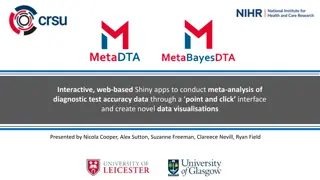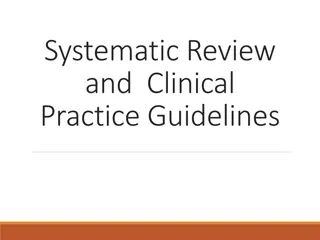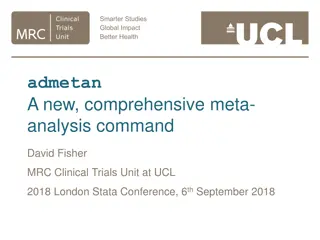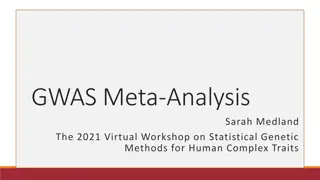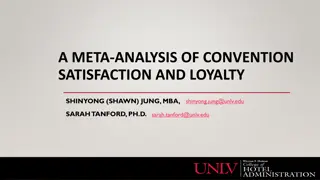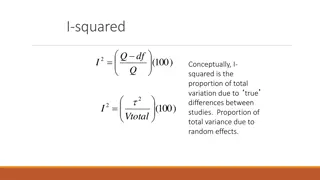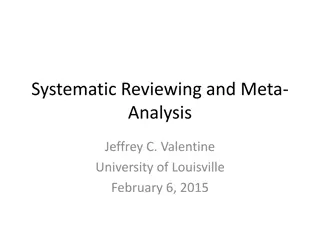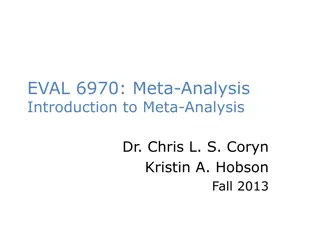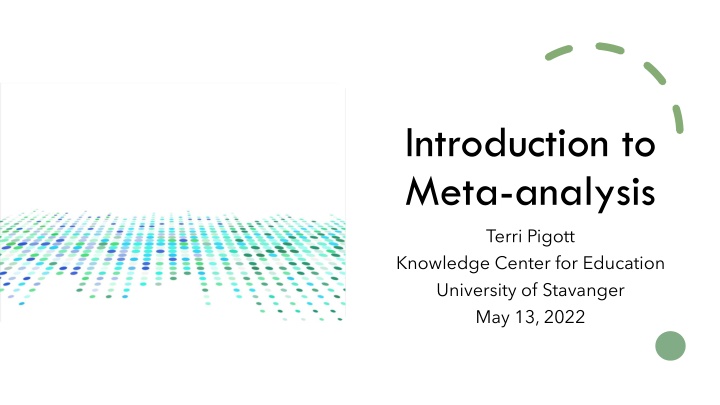
Understanding Meta-Analysis in Research
Discover the essential concepts of meta-analysis in educational research, including its relationship with systematic reviews, examples of questions addressed, and interpretations of results. Learn about the systematic review process, the different types of research synthesis methods, and the key steps involved in conducting a meta-analysis.
Download Presentation

Please find below an Image/Link to download the presentation.
The content on the website is provided AS IS for your information and personal use only. It may not be sold, licensed, or shared on other websites without obtaining consent from the author. If you encounter any issues during the download, it is possible that the publisher has removed the file from their server.
You are allowed to download the files provided on this website for personal or commercial use, subject to the condition that they are used lawfully. All files are the property of their respective owners.
The content on the website is provided AS IS for your information and personal use only. It may not be sold, licensed, or shared on other websites without obtaining consent from the author.
E N D
Presentation Transcript
Introduction to Meta-analysis Terri Pigott Knowledge Center for Education University of Stavanger May 13, 2022
Goals for the Presentation + Discuss the relationship between systematic review and meta-analysis + Provide examples of questions addressed by meta- analysis + Present examples of meta-analysis results + Consider interpretations of meta-analysis results
Definition of systematic review A systematic review Uses explicit criteria and transparent, replicable processes To identify, assess and synthesize results of multiple studies To address a central research question While minimizing bias and error at each step
This definition of systematic review Assumes that the goal of the review is to be transparent Assumes that the review is focused on synthesizing a set of studies identified through a replicable process There could be multiple ways that these studies are synthesized depending on the research question and relevant literature
SYSTEMATIC REVIEW OR RESEARCH SYNTHESIS Meta-Analysis Evidence and Gap Maps Conceptual Reviews Overviews Qualitative Synthesis Scoping Reviews
Today we will talk about meta- analysis + Meta-analysis is a set of statistical methods used to synthesize the quantitative results across a set of studies + We will focus on the synthesis of quantitative studies in this talk + I will also assume that a meta-analysis is being conducted using systematic review methods
Remember Systematic Reviews don't always include meta-analyses And some meta-analyses might not use systematic review techniques Today I assume that we are conducting a meta-analysis as part of a systematic review
1. Problem formulation 2. Searching the literature 3. Screening potentially eligible studies 4. Data extraction and coding 5. Data analysis and synthesis (meta-analysis) 6. Interpretation and dissemination 7. Re-analysis, development, or criticism Adapted from Johnson & Hennessy (2019)
Meta-Analysis steps After conducting a systematic search of the literature and screening for eligible studies, we extract measures of each studies effect This effect size is then used as the unit of analysis in the meta-analysis part of the systematic review
Types of questions addressed by meta-analysis
Types of questions relevant for meta- analysis Rates and Trends Associations Cause and Effect Any question where the goal is to estimate a quantitative measure across studies
Rates/Trends What is the prevalence of this behavior among persons with autism?
Associations - Correlations What is the correlation between spatial skills and mathematics performance? Does this correlation vary across studies?
Associations comparisons among groups What is the difference in academic achievement among first- and second-generation youths? How does that difference (if it exists) vary across studies?
What are typical results from a meta-analysis?
In a meta-analysis, we are concerned with: + Estimating the average effect size (treatment effectiveness, correlation between constructs, prevalence of a condition) and its confidence interval + Estimating the variation among studies in effect size or exploring the heterogeneity among studies
Forest plot from mindfulness review Mean effect size and 95% CI: 0.25, [0.06, 0.43]
Exploring heterogeneity Tool based on the Mathematics interventions here: https://www.air.org/centers/mosaic/mosaic-tools You can explore the effect sizes from different interventions, using different measures in varying contexts
What conclusions can we draw from a meta-analysis?
Meta-analysis questions As we have seen in our examples, meta-analysis results can Provide an estimate of the average effect across studies such as the average treatment effect, or the average correlation between constructs Describe how the amount of variation across studies Explore the relationship among study characteristics and effect size
Exploring heterogeneity and generalizing results + When we explore how study characteristics relate to effect size, we are really addressing a question about generalizability + With treatment effectiveness, we are exploring how much treatments vary, for whom they are most effective, and in what contexts they are effective + For other types of questions: how variable are the effects across studies?
Summary Meta-analysis is used in the context of a systematic review to synthesize results of quantitative studies Meta-analysis results can describe the average effect across studies, and examine the amount of variation in effects Meta-analysis can summarize what we know and what we don t yet know about a given research area
Thank you! TERRI PIGOTT TPIGOTT@GSU.EDU
General resources for systematic review Cooper, H. (2017). Research synthesis and meta-analysis: A step-by-step approach (Fifth). Sage Publications. Gough, D., Oliver, S., & Thomas, J. (2017). An introduction to systematic reviews (2nd ed.). Sage Publications.
Resources for Meta-analysis Cochrane Handbook for Systematic Reviews of Interventions (health-focused): https://training.cochrane.org/handbook Meta-analysis Learning Information Center (social science focused with R resources and videos): https://www.meta-analysis-learning-information- center.com/ Wolfgang Viechtbauer s metafor R package: https://www.metafor- project.org/doku.php/metafor
Books/Papers on meta-analysis Borenstein, M., Hedges, L. V., Higgins, J. P. T., & Rothstein, H. R. (2009). Introduction to Meta-Analysis (2nd ed.). Wiley. Cooper, H., Hedges, L. V., & Valentine, J. C. (2019). The Handbook of Research Synthesis and Meta-Analysis (3rd ed.). Russell Sage Foundation. Lipsey, M. W., & Wilson, D. B. (2001). Practical meta-analysis. Sage Publications. Pigott, T. D., & Polanin, J. R. (2020). Methodological Guidance Paper: High-Quality Meta-Analysis in a Systematic Review. Review of Educational Research, 90(1), 24 46. https://doi.org/10.3102/0034654319877153
Publication Bias Papers/Resources Egger, M., Smith, G. D., Schneider, M., & Minder, C. (1997). Bias in meta-analysis detected by a simple, graphical test. BMJ, 315(7109), 629 634. https://doi.org/10.1136/bmj.315.7109.629 Hedges, L. V., & Vevea, J. L. (1996). Estimating Effect Size Under Publication Bias: Small Sample Properties and Robustness of a Random Effects Selection Model. Journal of Educational and Behavioral Statistics, 21(4), 299 332. https://doi.org/10.3102/10769986021004299 Marks-Anglin, A., & Chen, Y. (2020). A historical review of publication bias. Research Synthesis Methods, 11(6), 725 742. https://doi.org/10.1002/jrsm.1452 Mathur, M. B., & VanderWeele, T. J. (2021). Estimating publication bias in meta-analyses of peer- reviewed studies: A meta-meta-analysis across disciplines and journal tiers. Research Synthesis Methods, 12(2), 176 191. https://doi.org/10.1002/jrsm.1464 Rodgers, M. A., & Pustejovsky, J. E. (2020). Evaluating meta-analytic methods to detect selective reporting in the presence of dependent effect sizes.. Psychological Methods, 26(2), 141-160.


